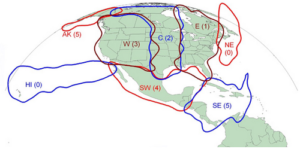Land Mobile Radio communication has been integral to a variety of industries for years and continues to be important today. However, as technology changes, existing terrestrial radio networks are starting to reach the end of their lifespan. This satellite service is a cost effective alternative to installing, maintaining, and relocating land-based two-way radio communications systems. Professionals in many industries including construction, forestry, and electrical utilities are making the transition from terrestrial radios to the G2 dispatch mobile satellite radio for reasons outlined in this article. There are several key benefits to using satellite radios over terrestrial land mobile based solutions:
Reliability of the Satellite Network
 The network of this geostantionary satellite covers North American and tip of Central America, the Caribbean, Hawaii, and coastal waters. While users of terrestrial land mobile radios have to depend on the coverage of cell towers, satellite dispatch radio users rarely experience service interruptions because of the singular network structure. During emergencies, should terrestrial land based communications become compromised, satellites are the only viable option for communications.
The network of this geostantionary satellite covers North American and tip of Central America, the Caribbean, Hawaii, and coastal waters. While users of terrestrial land mobile radios have to depend on the coverage of cell towers, satellite dispatch radio users rarely experience service interruptions because of the singular network structure. During emergencies, should terrestrial land based communications become compromised, satellites are the only viable option for communications.
Ease Of Setup and Use
Satellite radios are extremely easy to install and program for immediate access to the network. The MSAT-G2 mobile satellite radio is comprised of three core component parts: the transceiver unit (the small black box), the antenna system (white domes), and the handset. An optional external speaker may be connected to the TU for remote monitoring. Serial and ethernet ports are provided for external interfacing, debugging, software upgrading, and future expansion capabilities.
The antenna unit is composed of the antenna element array, necessary high power and low noise amplifier systems, and a tracking system. Two AU versions exist: a 2-axis unit intended for land-mobile and fixed-site installations and a 3-axis unit for the maritime environment. Connection to both AUs is made by a TNC connector. The single co-axial cable carries RX,TX, power and tracking information. There is only one power connection for the entire radio. This must be connected to a 12 VDC power supply. The G2 also allows for the interfacing of devices with current terrestrial communications, so there is no need to worry about excessive downtime when implementing these systems.
Satellite Radio Security
 G2 dispatch mobile satellite radio implements the IMBE, or Improved Multi-Band Excitation codec, which was created in the early 90s. IMBE is the current standard for many digital communication networks across the globe. Thanks to digital scrambling and coding technology, communications are safe from eavesdropping and call monitoring. This is especially important for those in certain industries, such as law enforcement and electrical utilities, where it’s essential to have confidential transmissions.
G2 dispatch mobile satellite radio implements the IMBE, or Improved Multi-Band Excitation codec, which was created in the early 90s. IMBE is the current standard for many digital communication networks across the globe. Thanks to digital scrambling and coding technology, communications are safe from eavesdropping and call monitoring. This is especially important for those in certain industries, such as law enforcement and electrical utilities, where it’s essential to have confidential transmissions.
Today, a diverse group of end users, from oil professionals communicating on opposite ends of a job site to police officers in rural areas of the US reporting information back to headquarters, are making the switch to satellite dispatch radios.

